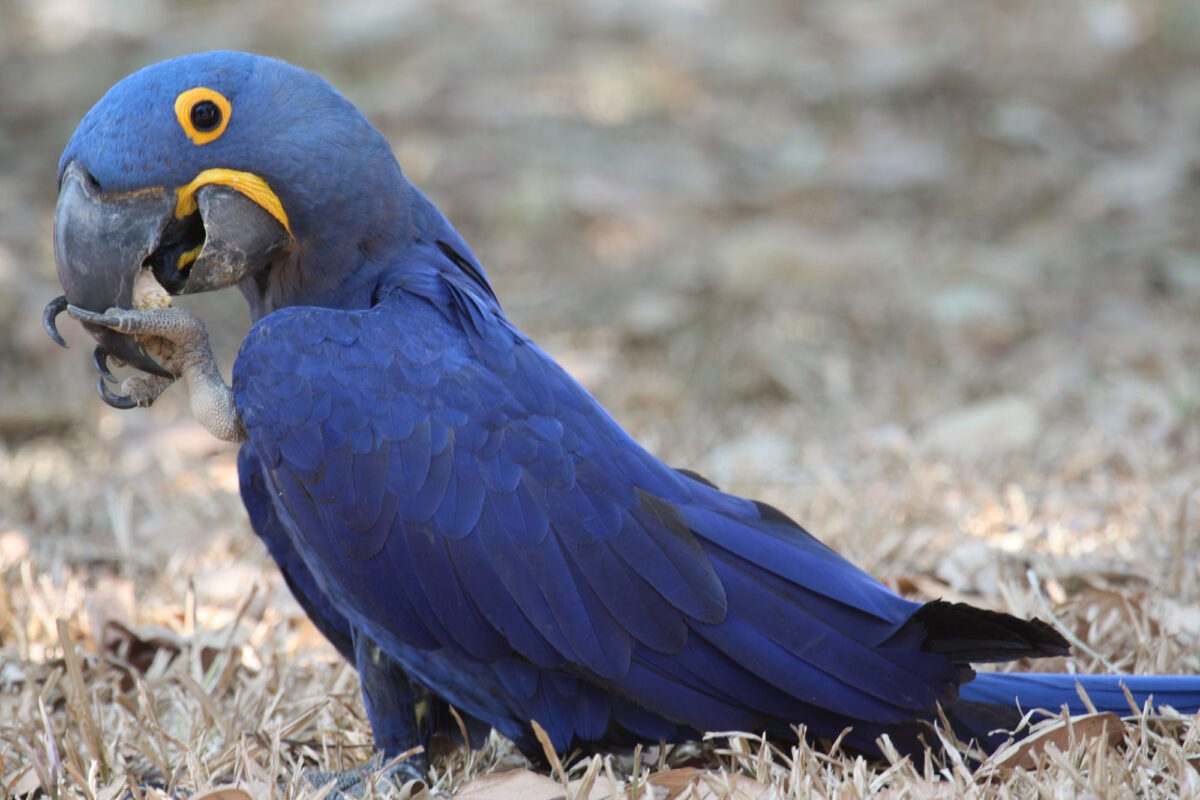Page snapshot: An overview of bird plumage, including how birds see color and how birds' feathers get their colors.
Topics covered on this page: Introduction; What colors can birds see?; How do bird feathers get their colors?; Resources.
Credits: Funded by the National Science Foundation. Any opinions, findings, and conclusions or recommendations expressed in this material are those of the author(s) and do not necessarily reflect the views of the National Science Foundation. Page by Elizabeth J. Hermsen
Updates: Page last updated May 13, 2024.
Image above: A hyacinth macaw (Anodorhynchus hyacinthinus), Mato Grosso do Sul, Brazil, 2012. In birds, blue feathers have structural color. Photo by Alastair Rae (flickr, Creative Commons Attribution-ShareAlike 2.0 Generic license, image resized).
Introduction
Plumage, the name for all of a bird's feathers, is often the most striking feature about a bird. Bird plumage colors range from browns, tans, grays, and whites to bright reds, greens, pinks, and blues. The colors, patterns, and shapes of a bird's plumage may have a variety of functions, such as providing camouflage or signaling to a mate. Plumage may also contain features that are outside of the visible spectrum, or the spectrum of colors that humans can see, because most birds can see a wider variety of colors than people can. On this page, we will explore the bird color vision and how bird feathers get their colors.
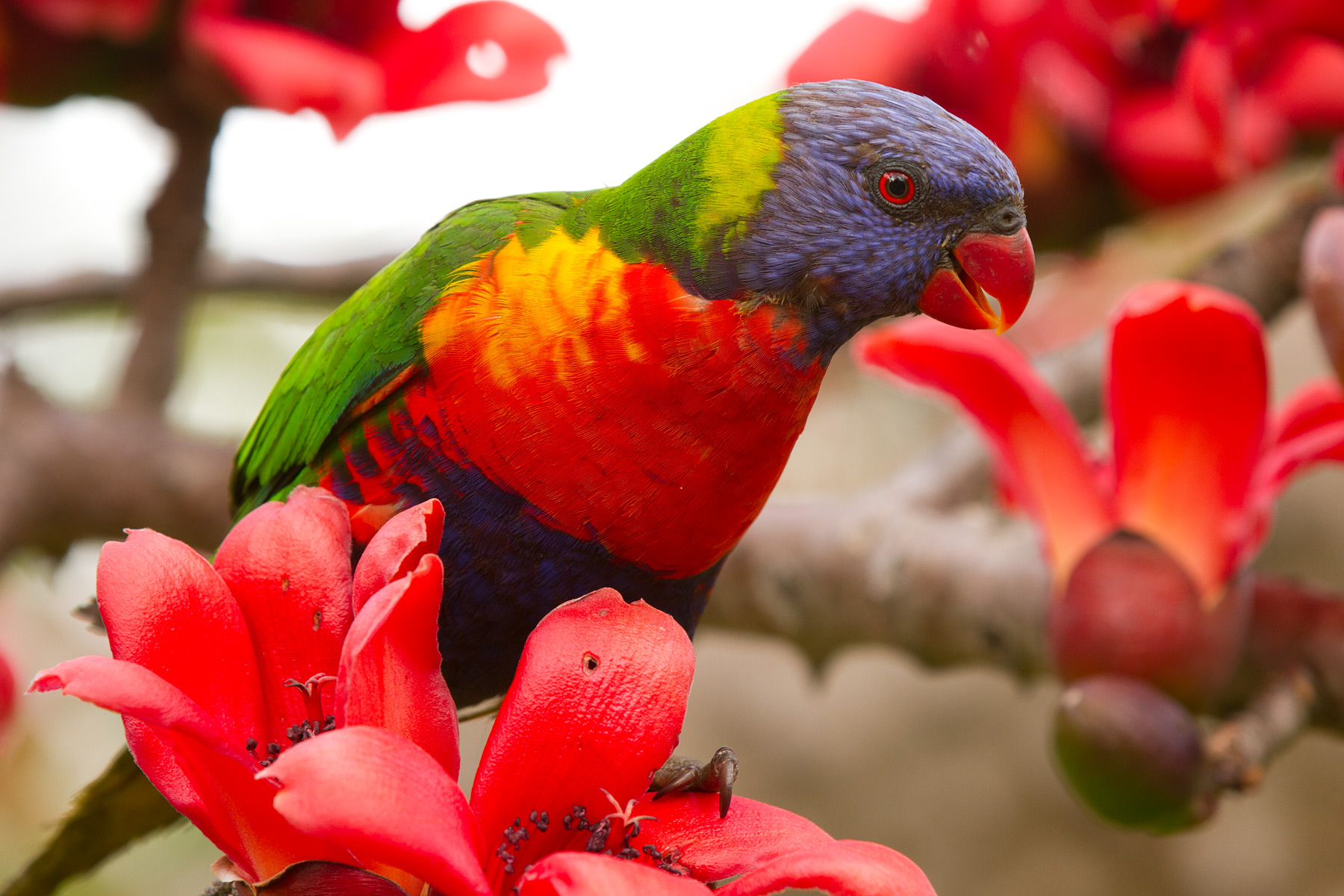
A rainbow lorikeet (Trichoglossus moluccanus), Brisbane, Queensland, Australia. Photo by Andrew Mercer (Wikimedia Commons, Creative Commons Attribution-ShareAlike 4.0 International license).

A red-tailed hawk (Buteo jamaicensis), Central Park, New York City, USA. Photo by Rododendrites (Wikimedia Commons, Creative Commons Attribution-ShareAlike 4.0 International license, image cropped and resized).
What colors can birds see?
Most birds see a greater range of colors than humans. Humans have three types of color-detecting structures called cones in their eyes. These cones can detect three colors: red, blue, and green. This is known as trichromatic vision. The spectrum of colors that humans can see can ranges from violet to red, a spectrum of light known as the "visible spectrum." When expressed in wavelengths of light, humans can see light at wavelengths from about 400 to 700 nanometers.
Birds that are active during the day, however, often have tetrachromatic vision, meaning that they have four types of cones in their eyes that detect color. These cones detect red, blue, green, and UV light. Therefore, birds can see the colors humans can see. They can also see some light in the ultraviolet (UV) part of the spectrum, which humans cannot see. The UV light that birds can seen ranges from wavelengths of about 300 to 400 nanometers. Light in this range is mostly classified as UV-A (long-wave ultraviolet light). To add to their tetrachromatic vision, the cones in bird's eyes also have special oil droplets that enhance their ability to see different colors.
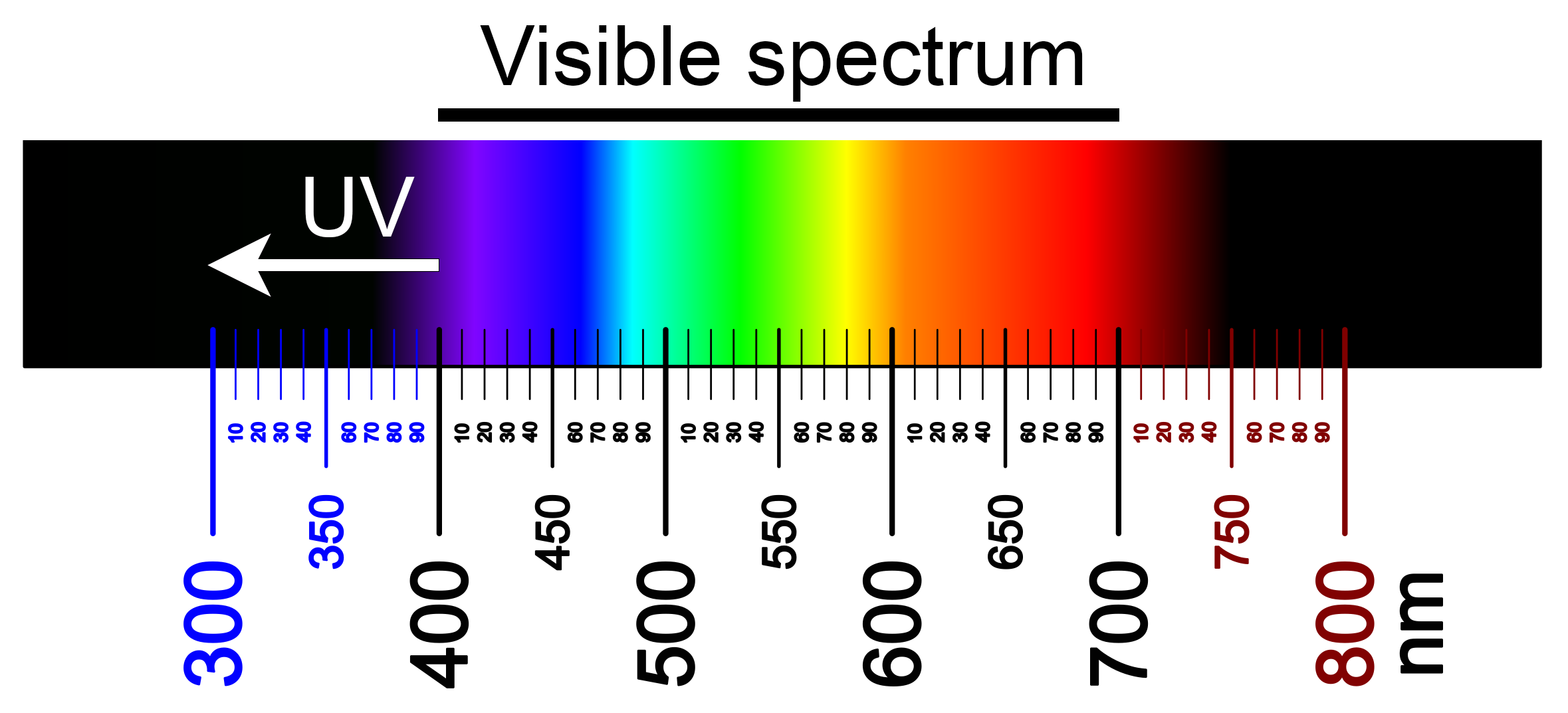
Color spectrum. The range of color visible to humans is usually considered to be roughly 400–700 nm, with peaks in the blue, green, and red wavelengths. UV light is light in the 10–400 nm range, and many birds can see UV light in the 200–400 nm range. Image credit: Color spectrum (Fulvio314, via Wikimedia Commons, CC BY-SA 4.0, image modified from original).
What good is seeing ultraviolet light?
Seeing the UV part of the light spectrum allows birds to see many things that humans cannot see. Some birds have plumage that interacts with UV light. Their feathers may reflect UV light or fluoresce under UV light. When objects fluoresce, they appear to glow under UV, sometimes with bright colors like green or red. UV reflectance and fluorescence can be detected using a blacklight or a special UV filter on a camera. Other markings, such as those on a puffin's beak, may also interact with UV.
Researchers believe that the addition of UV colors may make bird plumage look more vivid to other birds. Sometimes birds have UV patterns that are not visible to the human eye. While we cannot see exactly what birds see, special lighting techniques or images with modified colors can give us an idea of how plumage that reflects or glows under UV light might look to a bird.
The ability to see UV light also helps some birds of prey to hunt. For example, the urine of a type of rodent known as a vole reflects UV light. Eurasian kestrels, a type of raptor, can look for the urine trails of voles to determine if a particular area is a good hunting ground.
"Which bird should you take to a rave?" BBC Earth Unplugged via YouTube.
UV colors show up elsewhere in the natural world. For example, some flowers have ultraviolet patterns that are thought to signal to bees, which can see UV light, where they can find nectar. Some mammals are known to have fur that glows under UV light. Although some mammals can see UV light, the function of fluorescent fur in mammals is not entirely clear. In fact, the glowing fur of these animals may not have a purpose, but may simply be a byproduct of their fur structure and color. Some reptiles and invertebrates—most famously, scorpions—also fluoresce (glow) under UV light.

A scorpion glowing under UV light, Mojave Desert, California, USA. Photo by Jerry Kirkhart (flickr, Creative Commons Attribution 2.0 Generic license, image resized).
How do bird feathers get their colors?
Pigments
Some feather colors are produced by pigments, compounds deposited in a feather that reflect certain wavelengths of light. Colors like yellows, oranges, reds, browns, blacks, and some greens are created by pigments.
Some of these pigments, like black, brown, yellow, gray, and reddish melanins, are produced by the birds themselves. Eumelanin makes darker colors, like dark brown and black. Pheomelanin makes lighter colors that are reddish or yellowish. These pigments are also found in other types of animals, including humans, where they occur in skin, hair, and eyes. In birds, melanin also strengthens feathers.
Birds feathers get some colors, namely yellow, orange, red, and purple, from carotenoid pigments that come from their diets. A good example is the flamingo, which gets its pink color from eating certain types of algae or shrimp. A few other types of pigments can give feathers red, yellow, or occasionally green colors. The turacos, an unusual group of African birds, have copper-containing green and red porphyrin-based pigments.

The black feathers of the common raven (Corvus corax) contain melanin pigments; eumelanin can make feathers black. Photo by Dario Taraborelli (iNaturalist, public domain).
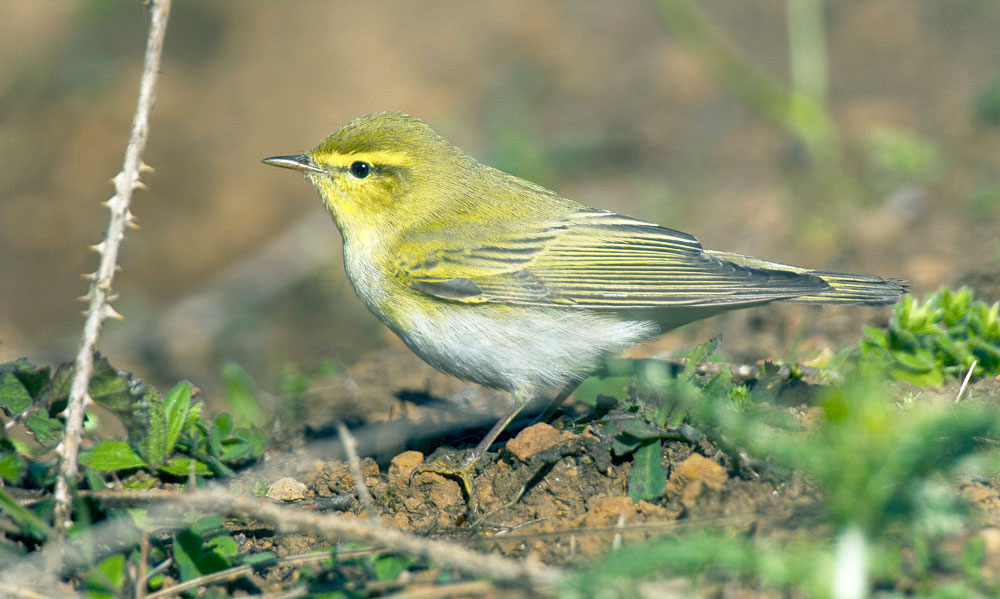
The yellow color a the wood warbler (Phylloscopus sibilatrix) comes from carotenoid pigments. Photo by Francesco Veronesi (Wikimedia Commons, Creative Commons Attribution-ShareAlike 2.0 Genric license, image cropped).
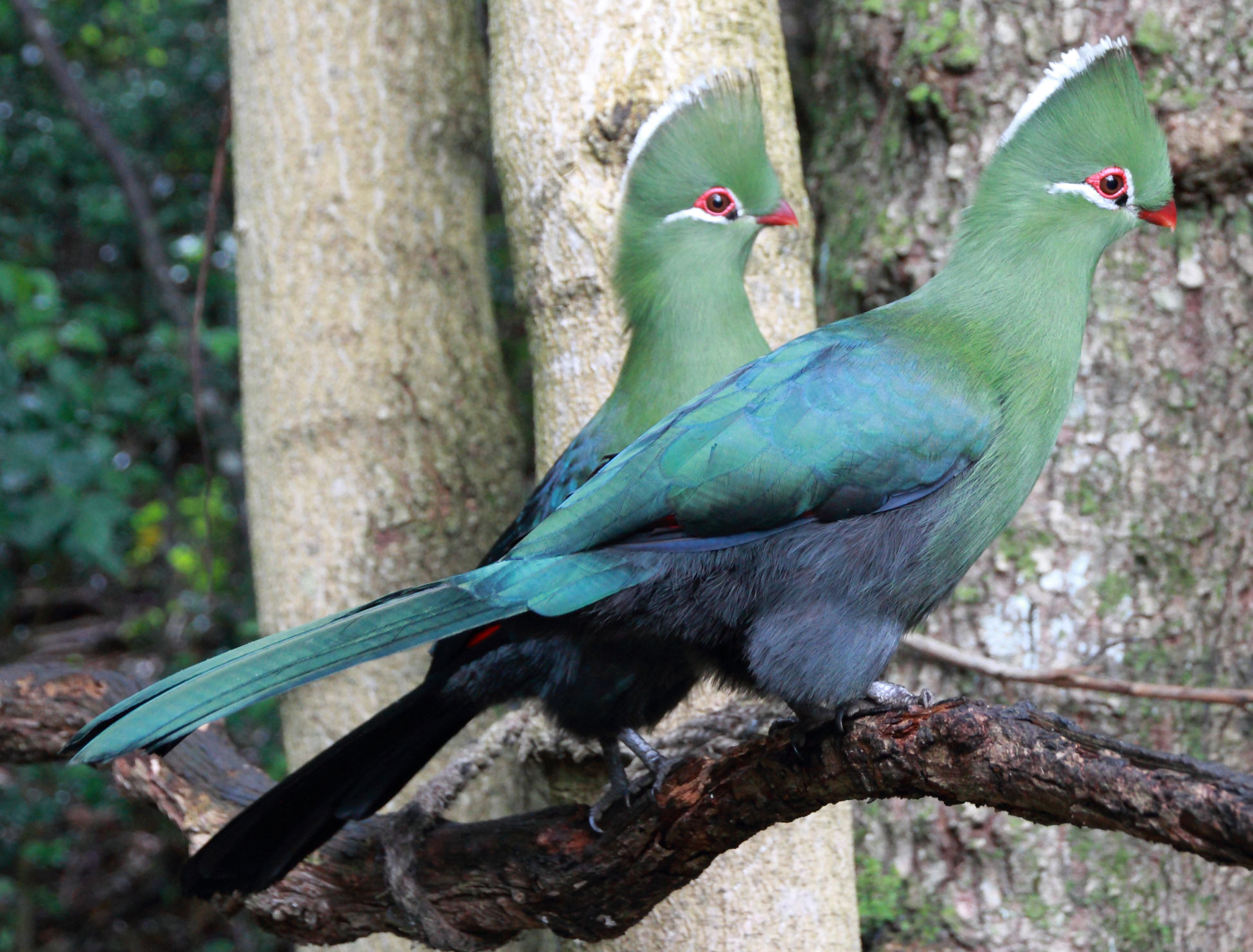
Southern knysna turaco (Tauraco corythaix subspecies corythaix). Turacos are a group of birds native to Africa that have green copper-containing feather pigments (turacoverdin). They also have red feathers on their wings (not visible above, but visible when their wings are spread) that have non-carotenoid pigments (turacin). Photo by Anton Frolich (Wikimedia Commons, Creative Commons Attribution-ShareAlike 3.0 Unported license, image cropped).
Structural colors
Structural colors are not produced by pigments. Instead, they are produced by the structural characteristics of a feather, which reflect certain wavelengths of light. Ultraviolet, white, blue, purple, iridescent, and most green colors in birds are structural.
Feathers with structural colors often also contain pigments, like black or gray melanins. These pigments absorb the colors that are not reflected by the feather structures. Pigments can also combine with structural colors to produce a third color. For example, a feather with yellow pigment and blue structural color will appear green.
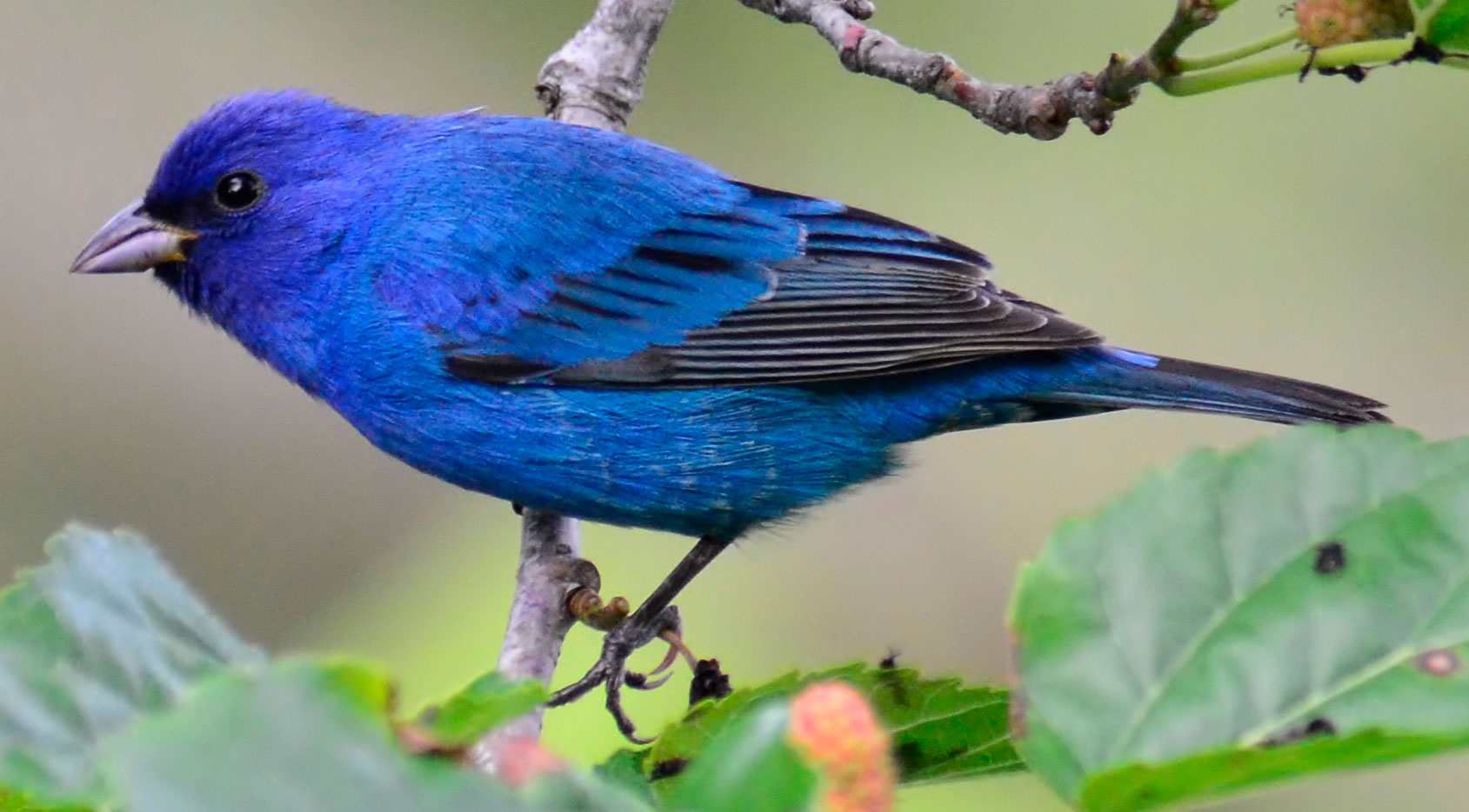
The blue of an indigo bunting's (Passerina cyanea) feathers is a type of structural color. The blue feathers have a sponge-like layer within them that reflects blue light; other colors are absorbed by a black layer containing melanin pigments. Photo by Gareth Rasberry (Wikimedia Commons, Creative Commons Attribution-ShareAlike 3.0 Unported license, image cropped).
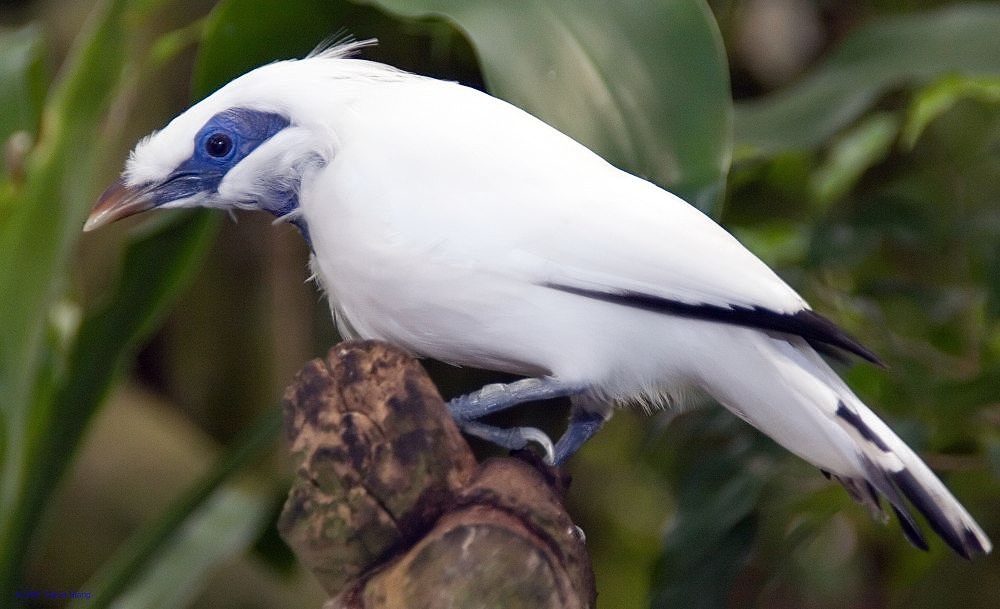
The white of the Bali Myna (Leucospar rothschildi) is a structural color. White is a result of all colors in the visible spectrum being reflected. Photo by David J. Stang (Wikimedia Commons, Creative Commons Attribution-ShareAlike 4.0 International license).
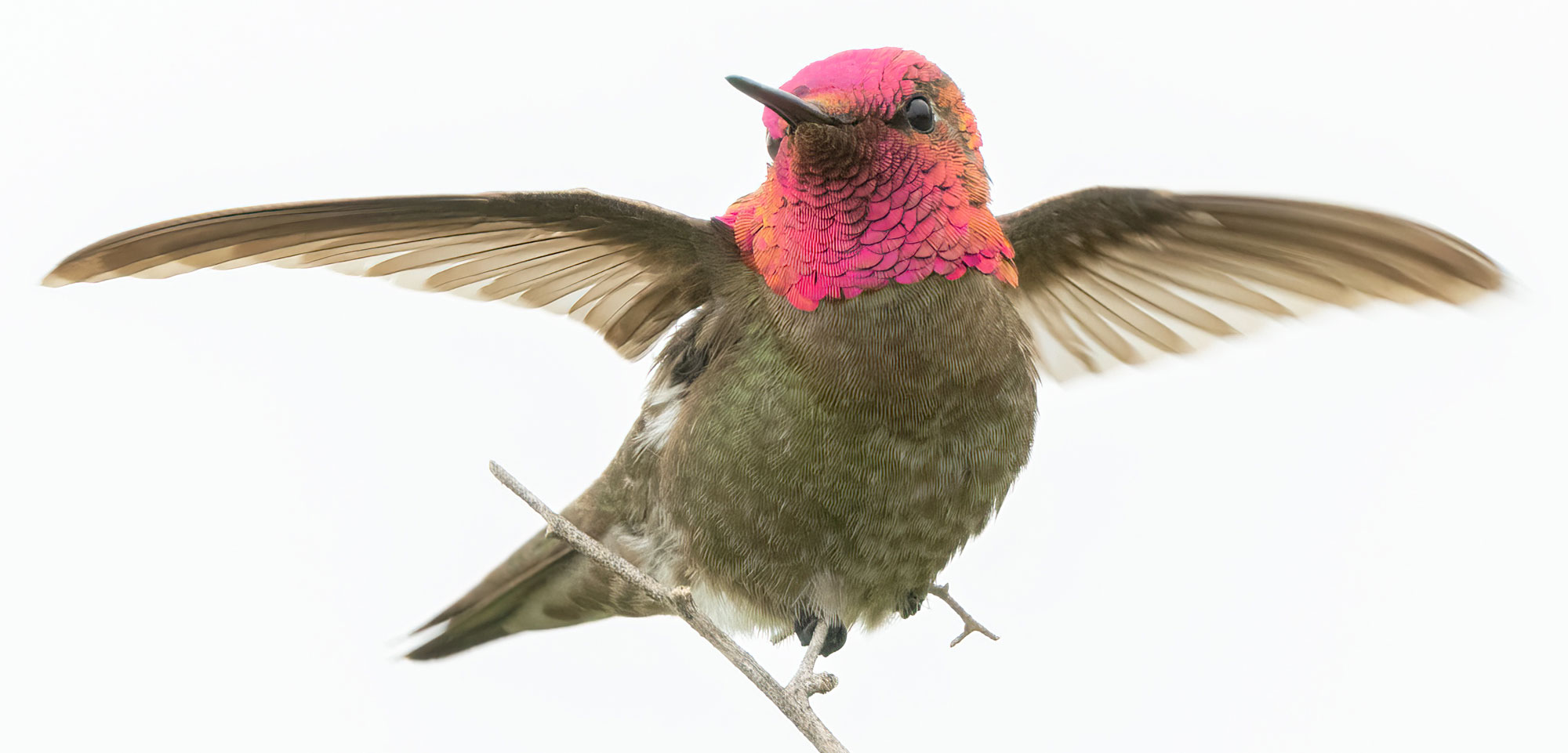
Iridescent feathers on the head of a male Anna's hummingbird (Calypte anna) get their shifting color from their structural characteristics. Photo by Sue Cook (flickr, Creative Commons 2.0 Generic license, image cropped and resized).
Resources
Websites
How birds make colorful feathers (Cornell Lab Bird Academy): https://academy.allaboutbirds.org/how-birds-make-colorful-feathers/
Why does the kingfisher have blue feathers? (University of Cambridge Research): https://www.cam.ac.uk/research/features/why-does-the-kingfisher-have-blue-feathers
Articles & reports
Berger, C. 2012. True colors: How birds see the world. National Wildlife Federation, 19 July 2012. https://www.nwf.org/Magazines/National-Wildlife/2012/AugSept/Animals/Bird-Vision
Devokaitis, M. 2023. What is the essence of iridescence? Ask a hummingbird. All About Birds, 28 June 2023. https://www.allaboutbirds.org/news/what-is-the-essence-of-iridescence-ask-a-hummingbird/
Giaimo, C. 2023. The glowing secret that mammls have been hiding. The New York Times, 20 October 2023. https://www.nytimes.com/2023/10/20/science/glowing-fluorescent-mammals-ultra-violet.html
Goldman, J.G. 2016. What makes bird feathers so colorfully fabulous? Audobon Magazine, 4 March 2016. https://www.audubon.org/news/what-makes-bird-feathers-so-colorfully-fabulous
GrrlScientist. 2007. Schemochromes: the physics of structural plumage colors. The Guardian, 16 Oct 2007. https://www.theguardian.com/science/punctuated-equilibrium/2007/oct/16/birds-physics
Pérez-Rodríguez, L. 2013. La medición del color: técnicas y fundamentos para el estudio de la ecología de las aves [The measurement of color: techniques and foundations for the study of the ecology of birds]. Revista de Anillamiento 31-32: 4-20.
Wilson, H. 2020. The physics of hummingbird colors. Maine Birds, 17 August 2020. https://web.colby.edu/mainebirds/2020/08/17/the-physics-of-hummingbird-colors/
Withgott, J. 2000. Taking a bird's-eye view . . . in the UV: Recent studies reveal a surprising new picture of how birds see the world. BioScience 50: 854-859. https://doi.org/10.1641/0006-3568(2000)050[0854:TABSEV]2.0.CO;2
Scientific articles
Dunning, J., A.W. Diamond, S.E. Christmas, E.-L. Cole, R.L. Holberton, H.J. Jackson, K.G. Kelly, D. Brown, I. Rojas Rivera, and D. Hanley. 2018. Photoluminescence in the bill of the Atlantic puffin Fatercula arctica. Bird Study 65: 570-573. https://doi.org/10.1080/00063657.2018.1563771
Eliason, C.M., M.J. Andersen, and S.J. Hackett. 2019. Using historical biogeography models to study color pattern evolution. Systematic Biology 68: 755-766. https://doi.org/10.1093/sysbio/syz012
Eliason, C.M., J.M. McCullough, S.J. Hackett, M.J. Andersen. 2023. Complex plumages spur rapid color diversification in kingfishers (Aves: Alcedinidae). eLife 12: e83426. https://doi.org/10.7554/eLife.83426
Hausmann, F., K.E. Arnold, N.J. Marshall, and I.P.F. Owens. 2003. Ultraviolet signals in birds are special. Proceedings of the Royal Society London B 270: 61-67. https://doi.org/10.1098/rspb.2002.2200
Lee, E., H. Bae, D.-J. Jeon, S. Ji, J.-S. Yeo, and J. Kim. 2021. Microstructures in blue feathers of the common kingfisher. Proceedings of the National Institute of Ecology of the Republic of Korea 2: 21-25. https://doi.org/10.22920/PNIE.2021.2.1.21
Sela-Klein, D., Y. Lavner, and Y. Vortman. 2022. Breeding biology of the white-throated kingfisher Halcyon smyrnensis smyrnensis, with emphasis on color and vocalization. Journal of Ornithology 164: 151-161. https://doi.org/10.1007/s10336-022-02026-8
Stavenga, D.G., J. Tinbergen, H.L. Leertouwer, and B.D. Wilts. 2011. Kingfisher feathers-colouration by pigments, spongy nanonstructures and thin films. Journal of Experimental Biology 214: 3960-3967. https://doi.org/10.1242/jeb.062620
Toomey, M.B., and J.C. Corbo. 2017. Evolution, development and function of vertebrate cone oil droplets. Frontiers in Neural Circuits 11. https://doi.org/10.3389/fncir.2017.00097
Viitala, J., E. Korplmäki, P. Palokangas, and M. Koivula. 1995. Attraction of kestrels to vole scent marks visible in ultraviolet light. Nature 373: 425-427. https://doi.org/10.1038/373425a0



